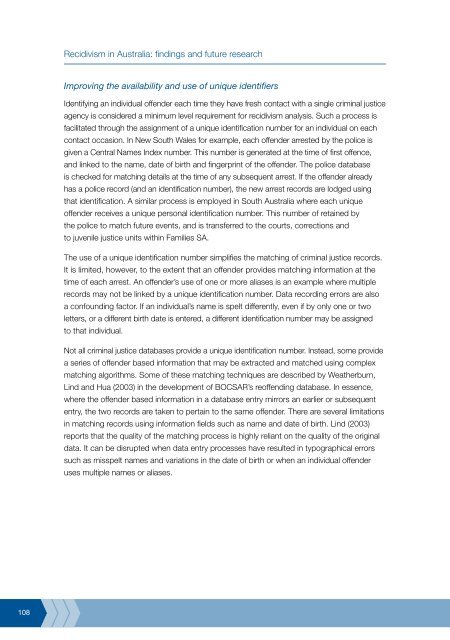Recidivism in Australia : findings and future research - Australian ...
Recidivism in Australia : findings and future research - Australian ...
Recidivism in Australia : findings and future research - Australian ...
You also want an ePaper? Increase the reach of your titles
YUMPU automatically turns print PDFs into web optimized ePapers that Google loves.
108<br />
<strong>Recidivism</strong> <strong>in</strong> <strong>Australia</strong>: f<strong>in</strong>d<strong>in</strong>gs <strong>and</strong> <strong>future</strong> <strong>research</strong><br />
Improv<strong>in</strong>g the availability <strong>and</strong> use of unique identifiers<br />
Identify<strong>in</strong>g an <strong>in</strong>dividual offender each time they have fresh contact with a s<strong>in</strong>gle crim<strong>in</strong>al justice<br />
agency is considered a m<strong>in</strong>imum level requirement for recidivism analysis. Such a process is<br />
facilitated through the assignment of a unique identification number for an <strong>in</strong>dividual on each<br />
contact occasion. In New South Wales for example, each offender arrested by the police is<br />
given a Central Names Index number. This number is generated at the time of first offence,<br />
<strong>and</strong> l<strong>in</strong>ked to the name, date of birth <strong>and</strong> f<strong>in</strong>gerpr<strong>in</strong>t of the offender. The police database<br />
is checked for match<strong>in</strong>g details at the time of any subsequent arrest. If the offender already<br />
has a police record (<strong>and</strong> an identification number), the new arrest records are lodged us<strong>in</strong>g<br />
that identification. A similar process is employed <strong>in</strong> South <strong>Australia</strong> where each unique<br />
offender receives a unique personal identification number. This number of reta<strong>in</strong>ed by<br />
the police to match <strong>future</strong> events, <strong>and</strong> is transferred to the courts, corrections <strong>and</strong><br />
to juvenile justice units with<strong>in</strong> Families SA.<br />
The use of a unique identification number simplifies the match<strong>in</strong>g of crim<strong>in</strong>al justice records.<br />
It is limited, however, to the extent that an offender provides match<strong>in</strong>g <strong>in</strong>formation at the<br />
time of each arrest. An offender’s use of one or more aliases is an example where multiple<br />
records may not be l<strong>in</strong>ked by a unique identification number. Data record<strong>in</strong>g errors are also<br />
a confound<strong>in</strong>g factor. If an <strong>in</strong>dividual’s name is spelt differently, even if by only one or two<br />
letters, or a different birth date is entered, a different identification number may be assigned<br />
to that <strong>in</strong>dividual.<br />
Not all crim<strong>in</strong>al justice databases provide a unique identification number. Instead, some provide<br />
a series of offender based <strong>in</strong>formation that may be extracted <strong>and</strong> matched us<strong>in</strong>g complex<br />
match<strong>in</strong>g algorithms. Some of these match<strong>in</strong>g techniques are described by Weatherburn,<br />
L<strong>in</strong>d <strong>and</strong> Hua (2003) <strong>in</strong> the development of BOCSAR’s reoffend<strong>in</strong>g database. In essence,<br />
where the offender based <strong>in</strong>formation <strong>in</strong> a database entry mirrors an earlier or subsequent<br />
entry, the two records are taken to perta<strong>in</strong> to the same offender. There are several limitations<br />
<strong>in</strong> match<strong>in</strong>g records us<strong>in</strong>g <strong>in</strong>formation fields such as name <strong>and</strong> date of birth. L<strong>in</strong>d (2003)<br />
reports that the quality of the match<strong>in</strong>g process is highly reliant on the quality of the orig<strong>in</strong>al<br />
data. It can be disrupted when data entry processes have resulted <strong>in</strong> typographical errors<br />
such as misspelt names <strong>and</strong> variations <strong>in</strong> the date of birth or when an <strong>in</strong>dividual offender<br />
uses multiple names or aliases.















